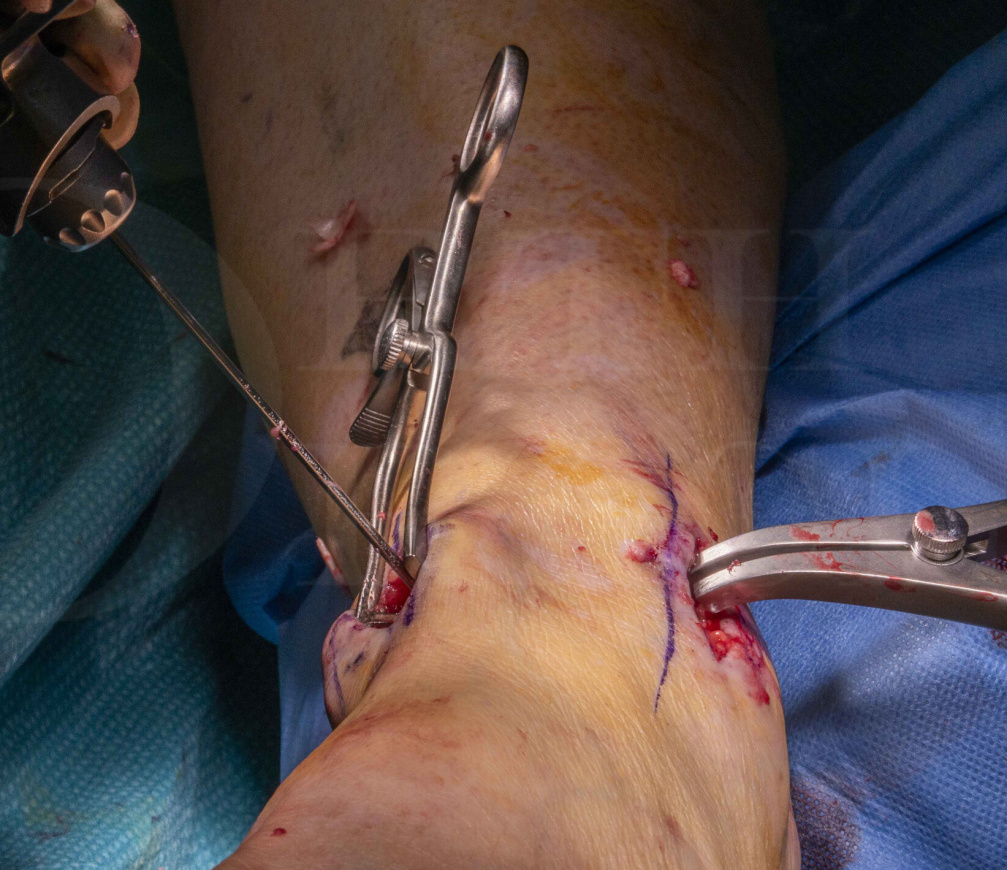Ankle arthrodesis(fusion): Mini-open technique (Arthrex 67mm Titanium cannulated screws)
Overview

Subscribe to get full access to this operation and the extensive Foot Surgery Atlas.
Learn the Ankle arthrodesis(fusion): Mini-open technique (Arthrex 67mm Titanium cannulated screws) surgical technique with step by step instructions on OrthOracle. Our e-learning platform contains high resolution images and a certified CME of the Ankle arthrodesis(fusion): Mini-open technique (Arthrex 67mm Titanium cannulated screws) surgical procedure.
Ankle arthrodesis is an established treatment for painful, end-stage ankle arthritis. Over the last century, a number of operative techniques have been popularised, with modifications reflecting technological advances. These have ranged in methods of fixation from the Charnley external clamps through to all manner of crossed/parallel screw fixation techniques. As a general rule however, treatment options must have the following attributes:
- Biologically friendly exposure techniques which protect the vulnerable soft tissue envelope, whilst offering good exposure of the joint surfaces, including the gutters.
- Meticulous preparation of the fusion surfaces.
- Robust stable fixation hardware
- Early return to function
- Reproducible satisfaction rates
- Minimal complication rates
Several approaches have been used for open ankle fusions, including the trans-fibular, anterior, as well as medial and posterior approaches. These have all had reasonable results with successful fusion, but are known to cause wound problems due to their extensile nature.
Minimally invasive arthroscopic surgery for ankle fusion is now the preferred option to most surgeons in the United Kingdom and mainland Europe. It is catching up rapidly around the world, as it is has been shown to offer predictably good fusion rates, fewer hospital stay days, and with minimal complication rates. My preferred choice for most hindfoot fusions now is minimally invasive arthroscopic surgery.
However it can have some limitations. The most common accepted limitation is how much fixed deformity can be corrected using only arthroscopic techniques. Arthroscopic techniques also require a degree of technical skill not only in ankle arthroscopy but specifically the nuances of the technique. A trans-fibular approach or other open technique is definitely an easier technical task, particularly in the presence of significant fixed intra-articular deformity.
Mini open approach uses more or less the traditional ankle arthroscopy portals, which are enlarged and positioned to suit the requirements of the individual ankle to be fused, and are straightforward for ankles with little or no deformity. Correcting large deformities however again large deformity is to push the boundaries of what it can achieve in terms of exposure. However minimal deformity or deformity where there is no bone loss such as when there is a chronic lateral ligament insufficiency, can be dealt with by this technique.
I specifically use this technique in situations where I suspect that the joint is tight and using arthroscopic techniques might be time consuming(such as after severe trauma or in patients with multiple previous surgeries), or the patient is in a poor physiological state that needs as short an operating time as possible.
Thus diabetics, patients with non-critical ischemia of the limb, patients who are physiologically less than optimal, post traumatic patients with large “curtain” osteophytes in the anterior part of the joint would form the main cohort of patients for whom I use this approach. The approach allows for direct visualisation of the joint surfaces whilst not using an extensile approach such as the trans-fibular approach for access and visualisation.
The hardware that I use for this procedure is of the same variety as in arthroscopic fusion. Thus, the combination of a quasi-minimal approach with the use of the same hardware as one would in a minimally invasive arthroscopic arthrodesis, but without the extensile nature of a fully open technique, makes this an attractive proposition for the categories of patients mentioned above. It is especially useful for surgeons with limited ankle arthroscopic experience who are called upon to fuse ankles as part of their normal practice.
The metalwork I use for this procedure is the Arthrex 6.7 mm cannulated screw which is what i use for my arthroscopic fusions too. There are several reasons for my using these specific implants:
- There are 2 thread lengths for use as appropriate 18 and 28 mm, though I usually use the short thread for this operation
- The threads are deeper than conventional cannulated screws as the cannulation is narrower allowing only a 2.4 mm guide wire
- Due to the larger thread height the pull out strength is 30% more than conventional cannulated screws
- The are self drilling and self tapping screws
- The screws are made of Type 2 anodised titanium which has very good bio-mechanical properties
OrthOracle readers will also find the following instructional techniques of interest on ankle as well as tibio-talo-calcaneal fusion, and also the many ankle replacement techniques that we cover:
Ankle Fusion: Arthrex anterior ankle fusion plate
Ankle Fusion (arthrodesis): Trans-fibular approach using AnkleFix 4.0 plate (Zimmer-Biomet)
Ankle arthrodesis (fusion): Arthroscopic assisted Ankle Fusion
Tibio-Talo-Calcaneal (TTC/Double )fusion using Zimmer Ankle Fix plus plate.
Tibio-Talo-Calcaneal (TTC/Double )fusion using Integra Advansys Plate
Tibio-talo-calcaneal (TTC/Double ) fusion with Wright Valor nail.
Tibio-talo-calcaneal(double) fusion using OrthoSolutions Oxbridge nail
Tibio-talo-calcaneal(double) fusion using De Puy Versa-Nail.
Author: Hari Haran FRCS (Tr & Orth)
Institution: Aneuran Bevan University Health Board, Wales.
Clinicians should seek clarification on whether any implant demonstrated is licensed for use in their own country.
In the USA contact: fda.gov
In the UK contact: gov.uk
In the EU contact: ema.europa.eu



















